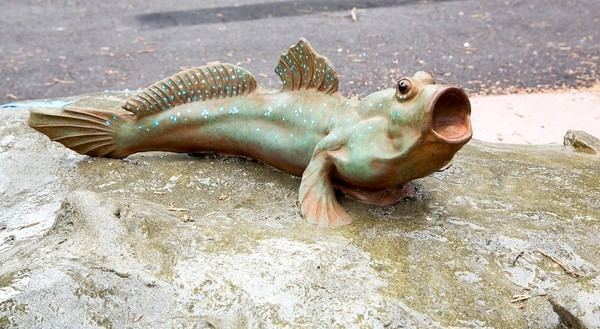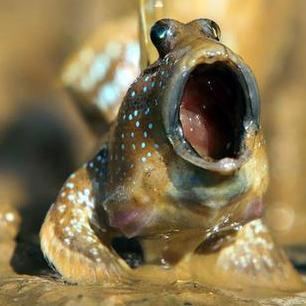Superclass Osteichthyes Order Perciformes Scientific name Oxudercinae Rank Subfamily | Phylum Chordata Superorder Acanthopterygii Suborder Gobioidei Higher classification Goby | |
 | ||
Lower classifications Periophthalmus, Pseudapocryptes elongatus | ||
Mudskippers are amphibious fish, presently included in the subfamily Oxudercinae, within the family Gobiidae (gobies). Recent molecular studies do not support this classification, as oxudercine gobies appear to be paraphyletic relative to amblyopine gobies (Gobiidae: Amblyopinae), thus being included in a distinct "Periophthalmus lineage", together with amblyopines. Mudskippers can be defined as oxudercine gobies that are "fully terrestrial for some portion of the daily cycle" (character 24 in Murdy, 1989). This would define the species of the genera Boleophthalmus, Periophthalmodon, Periophthalmus, and Scartelaos as "mudskippers". However, field observations of Zappa confluentus suggest that this monotypic genus should be included in the definition. These genera presently include 32 species. Mudskippers use their pectoral fins and pelvic fins to walk on land They typically live in intertidal habitats, and exhibit unique adaptations to this environment that are not found in most intertidal fishes, which typically survive the retreat of the tide by hiding under wet seaweed or in tide pools.
Contents
Mudskippers are quite active when out of water, feeding and interacting with one another, for example, to defend their territories and court potential partners. They are found in tropical, subtropical, and temperate regions, including the Indo-Pacific and the Atlantic coast of Africa.

Mudskipper land of dragons nature planet doc full documentaries
Adaptations

Compared with fully aquatic gobies, these fish present a range of peculiar behavioural and physiological adaptations to an amphibious lifestyle. Anatomical and behavioural adaptations that allow them to move effectively on land as well as in the water. As their name implies, these fish use their fins to move around in a series of skips.

Mudskippers have the ability to breathe through their skin and the lining of their mouth (the mucosa) and throat (the pharynx): This is only possible when the mudskippers are wet, limiting them to humid habitats and requiring they keep themselves moist. This mode of breathing, similar to that employed by amphibians, is known as cutaneous air breathing. Another important adaptation that aids breathing while out of water is their enlarged gill chambers, where they retain a bubble of air. These chambers close tightly when the fish is above water, due to a ventromedial valve of the gill slit, keeping the gills moist, and allowing them to function while exposed to air. Gill filaments are stiff and do not coalesce when out of water.
Digging deep burrows in soft sediments allow the fish to thermoregulate, avoid marine predators during the high tide when the fish and burrow are submerged, and lay their eggs. When the burrow is submerged, several mudskipper species maintain an air pocket inside it, which allows them to breathe in conditions of very low oxygen concentration.
Species
The genus Periophthalmus is by far the most diverse and widespread genus of mudskipper. Eighteen species have been described. Periophthalmus argentilineatus is one of the most widespread and well-known species. It can be found in mangrove ecosystems and mudflats of East Africa and Madagascar east through the Sundarbans of Bengal, Southeast Asia to Northern Australia, southeast China, and southern Japan, to Samoa and Tonga Islands. It grows to a length of about 9.5 cm and is a carnivorous opportunist feeder. It feeds on small prey such as small crabs and other arthropods. However, a recent molecular study suggests that P. argentilineatus is in fact a complex of species, with at least three separate lineages, one in East Africa, and two in the Indo-Malayan region. Another species, Periophthalmus barbarus, is the only oxudercine goby that inhabits the coastal areas of western Africa.
